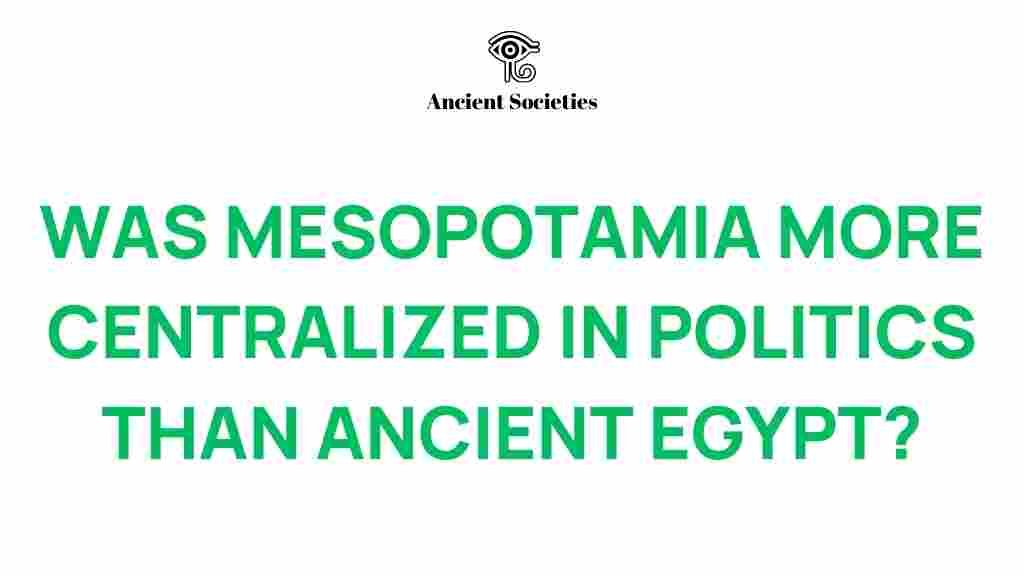Mesopotamia vs. Ancient Egypt: A Clash of Political Centralization
When we delve into the annals of human history, two of the most fascinating ancient civilizations emerge: Mesopotamia and Ancient Egypt. Both regions were cradle to some of the earliest forms of governance, societal structures, and cultural achievements. However, their approaches to political centralization and governance created distinct power dynamics that shaped their histories and civilizations. This article explores the intricacies of Mesopotamian and Ancient Egyptian governance, highlighting their similarities, differences, and the archaeological findings that illustrate their unique paths.
The Foundations of Political Centralization
Political centralization refers to the concentration of political power and authority within a central governing body or leader. In the context of Mesopotamia and Ancient Egypt, this concept played a crucial role in shaping their respective societies.
- Mesopotamia: This region, often referred to as the “land between rivers,” saw the emergence of city-states like Uruk, Ur, and Babylon. Each city-state had its own governance structure, often led by a king or a priest-king. The centralization of power varied significantly between these city-states.
- Ancient Egypt: In contrast, Ancient Egypt was characterized by a more unified political structure. The Pharaoh, considered a divine ruler, held absolute power over the land, which facilitated a more centralized form of governance.
Power Dynamics in Mesopotamia
The power dynamics in Mesopotamia were complex and multifaceted. The political landscape was marked by:
- City-States: Each city-state operated independently, leading to competition and conflict among them. This decentralized nature allowed for varied governance models and political systems.
- The Role of Religion: Religion played a significant role in governance. Many rulers derived their authority from religious institutions, which often led to the intertwining of political and religious power.
- Legal Codes: The introduction of legal codes, such as Hammurabi’s Code, marked a significant step towards political centralization by establishing laws that applied across city-states.
Governance in Ancient Egypt
Ancient Egypt’s governance was highly centralized, characterized by:
- Absolute Monarchy: The Pharaoh was seen as a god on earth, which legitimized his authority and allowed for a strong centralized government.
- Bureaucratic Structure: A complex bureaucracy emerged to assist the Pharaoh in managing resources, construction projects, and maintaining order throughout the kingdom.
- Unified Legal System: A coherent legal framework existed that was enforced uniformly across Egypt, further solidifying the centralization of power.
Archaeological Insights into Governance
Archaeological findings have provided invaluable insights into the governance structures of both Mesopotamia and Ancient Egypt.
- Mesopotamia: Excavations of ancient city-states have revealed temples, ziggurats, and administrative buildings that indicate a complicated social hierarchy and governance system.
- Ancient Egypt: The discovery of administrative papyri, monumental architecture like the pyramids, and tombs of Pharaohs showcases the centralized power and organizational capabilities of the Egyptian state.
Societal Impacts of Political Centralization
The political centralization in both civilizations had profound impacts on their societies:
- Social Stratification: In both Mesopotamia and Ancient Egypt, political centralization led to a pronounced social hierarchy.
- Economic Development: Centralized governance allowed for better resource management, trade regulation, and large-scale projects that stimulated economic growth.
- Cultural Flourishing: With a stable political environment, both civilizations experienced cultural advancements in writing, art, and science.
Comparison of Political Centralization: Strengths and Weaknesses
While both Mesopotamia and Ancient Egypt developed systems of governance that reflected their unique cultural values, their approaches to political centralization had distinct strengths and weaknesses:
- Mesopotamia:
- Strengths: Flexibility in governance allowed for adaptability to local needs.
- Weaknesses: Frequent conflicts between city-states often led to instability.
- Ancient Egypt:
- Strengths: Strong central authority fostered unity and stability across the kingdom.
- Weaknesses: Dependence on the Pharaoh’s divine status led to potential crises during transitions of power.
Lessons from History: Governance Today
The examination of Mesopotamia and Ancient Egypt provides valuable lessons for contemporary governance. Political centralization can lead to stability and coherence in policy implementation, but it also risks alienating local interests and creating tension. Modern societies can learn from these ancient civilizations by:
- Balancing central authority with local governance to ensure representation and responsiveness.
- Recognizing the role of culture and religion in shaping political authority and societal norms.
- Implementing legal frameworks that promote justice and equity across diverse populations.
Troubleshooting Governance Issues
Modern governance can face challenges reminiscent of those faced by ancient civilizations. Here are some common issues and potential solutions:
- Issue: Centralized power leading to corruption.
- Solution: Establish checks and balances within the government to promote transparency and accountability.
- Issue: Disconnection between the government and local communities.
- Solution: Foster community engagement initiatives to encourage citizen participation in governance.
- Issue: Social unrest due to inequality.
- Solution: Implement policies that promote social equity and address the needs of marginalized groups.
Conclusion
In summary, the examination of Mesopotamia and Ancient Egypt reveals profound insights into the processes of political centralization and governance. Each civilization’s approach to power dynamics shaped their historical trajectories and societal structures. Understanding these ancient systems not only enhances our comprehension of human history but also informs contemporary governance practices. As we reflect on these civilizations, we can appreciate the complexities of governance and the importance of balancing authority with community needs for a thriving society.
For further reading on the governance structures of ancient civilizations, check out this resource. You can also explore more about the archaeological findings in Mesopotamia and Ancient Egypt here.
This article is in the category History and created by AncientSocieties Team
